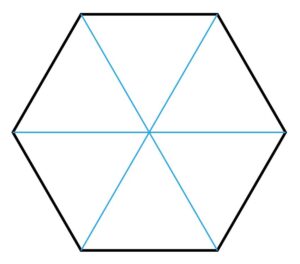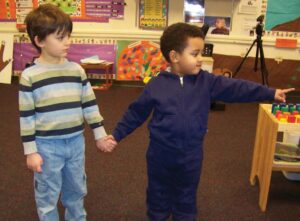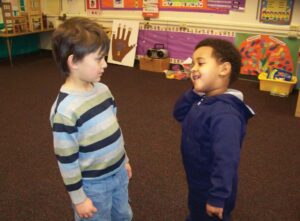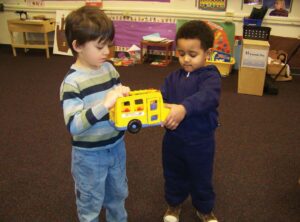Oral language, Print knowledge
Children will strengthen their understanding of how a book idea is used to write words and create illustrations.


New:
Illustration

Be Prepared: In advance of today’s activity, think about idea(s) from the Day 3 walk that can be moved into a simple book that involves children’s creative illustrations. Provide clear guidance in the opening part of the activity about the book topic while, at the same time, encouraging children to offer suggestions of what the book should say. Probably not all ideas on the Day 3 list can be incorporated into a class book. Children may wish to pursue some ideas in their own book at a later time.
Use children’s interests and book-making abilities to determine the complexity of the storyline and length of the book. One option is to create a basic description of the walk. Example: Our classroom walked (where). We saw many things (list them). We are excited about telling others about our walk. Another option is to pursue fiction possibilities with some of the things noticed during the walk. Examples: a squirrel turns one of the climber posts into a bedroom; an acorn shell is the ant’s house.
A straightforward way to make the book is to write key parts of the book (introduction, middle, end) on separate sheets of paper that serve as the book’s text pages. Children’s illustrations can follow pertinent text pages. Example: a drawing of children going on a walk would be put after the introduction. You may wish to write descriptive words or phrases on children’s pages. Encourage children to make an illustration that represents some part of the story.
Today and tomorrow are devoted to making the book.
[Display list from Day 3.]
Today we will use some ideas from our walk yesterday to write a book. We also will create illustrations for the book. An illustration is art found in a book. We can work on our book today and again tomorrow.
Let’s think about some of the things we saw and heard yesterday. Maybe we could write a book about (point to and read items you think are especially promising as the main character of the book, such as bird, squirrel, ant, delivery person, our class).
What do you think we should write about in our book?
[Encourage children to suggest topics. You may wish to offer your suggestions.]
Let’s write our book about (topic that seems to be of interest to most children).
Let’s think about what happens first in our book.
[Encourage children to suggest what is important about the topic. Examples: squirrel is looking for a place to live; children in our room were curious about a tree on their playground.]
We can start by writing a first sentence.
[Examples: squirrel is looking for a place to live; we were curious about a big tree on our playground.]
What could happen next?
[Help children describe the next event in the story. Examples: the bus was taking people to a store; the delivery person was bringing food to our center; a squirrel put a bucket on his head. You may wish to include a number. Examples: the squirrel saw four children; the tree has three big branches; the delivery person wheeled five boxes into our center.
Write a conclusion. Examples: we decided to give our big tree a name; the delivery person got in his truck and drove away; the squirrel decided to make our playground his home.
Read the text pages of the book.
If time permits, invite each child to begin creating a page that illustrates some part of the book. Children may wish to work in pairs or individually. Encourage children to describe what part of the book their illustration shows.]
We used ideas from our walk yesterday to begin writing a book. We decided what came first and then what came next. We followed Eric Carle’s ways of getting ideas for a book. What should we do tomorrow to finish making our book?
Extra support
Enrichment
Provide materials for children to finish or develop illustrations for the book.
Invite parents to read their favorite Eric Carle book to the children in your setting (can be done at any time during the week).
Geometric and spatial knowledge
Children will broaden their understanding that shapes can be combined to make new shapes.

For Option 2:

For Option 2:
New:
Review:
Offer the Week 9, Day 3 activity to review how to combine basic shapes.
Introduce a hexagon. This option includes supporting children in arranging triangles to make a hexagon.
 Display the hexagon cutout. Explain this shape is called a hexagon. A hexagon has six sides and six corners. Point out the hexagon’s six sides as you trace each side with your finger. Then count each of the six corners as you point to each.
Display the hexagon cutout. Explain this shape is called a hexagon. A hexagon has six sides and six corners. Point out the hexagon’s six sides as you trace each side with your finger. Then count each of the six corners as you point to each.
Display the hexagon cutout with triangles drawn inside it. Ask children what shape they see inside the hexagon. Describe and point to the six triangles inside the hexagon. Encourage children to count together the triangles as you point to each. Emphasize that six triangles of the same size can be used to make a hexagon.
Invite children to each make a hexagon by putting together six triangles. Give each child six triangles and a hexagon cutout with triangles drawn inside. Encourage children to put together their six triangles to make a hexagon. Children may place their triangle cutouts on top of each outlined triangle on the template, or they may put together their triangles to make a hexagon next to the hexagon cutout.
Motor development
Children will practice combinations of different physical movements.

None

For Option 2:
Review:

Offer the Week 22, Day 4 activity to practice marching, walking, jumping, and hopping.
Engage children in playing a game of Follow the Leader that combines marching, walking, jumping, and hopping.
Be Prepared: Consider offering this activity outdoors, weather permitting, if indoor space is limited.
Invite children to play a fun game called Follow the Leader. Explain that we play the game by following each other in a single line. The person at the front of the line is the leader. The leader decides how we will move and then leads us around our activity area. It might be helpful to demonstrate how to play this game with another adult.
Include up to four of the following movements in the game. Describe and invite volunteer children to demonstrate each movement before you begin the game.
Invite children to form a line. Make sure there is adequate space between children so no one bumps into the person in front of them. An adult should be the leader for the first round. If time permits, provide opportunities for children to take turns serving as the leader.
Getting Along With Others
Social-Emotional
Skill and Goal
Relationship skills
Children will strengthen their understanding of how to initiate play with others.
Materials
Needed
*Printables provided
Key
Concepts
Review:
Share
Offer the Week 1, Day 3 activity to review ways to initiate play with another child.
Describe what is happening in your room regarding children playing together. Examples: “Some children are new to our room. Sometimes we are not sure how to start playing together.” “Sometimes we want to play with someone but we do not know how to ask to
children playing together. Examples: “Some children are new to our room. Sometimes we are not sure how to start playing together.” “Sometimes we want to play with someone but we do not know how to ask to  play.”
play.”
Introduce the book. Explain our book today will give us some ideas about how to join other children who are playing. Encourage children to listen carefully to how the girl in the story tries to join other children who are playing.
are playing. Encourage children to listen carefully to how the girl in the story tries to join other children who are playing.
Read Join in and Play. At the conclusion of the book, encourage children to describe how the girl tried to join others as they played. Show pictures from the book to provide reminders.
Display and describe the three provided pictures, one at a time. For each picture, ask children what is happening in the picture and whether the girl in the book used this way to join another child in playing. After all pictures have been discussed, ask children whether the girl used any other ways to join someone who is playing or whether they have another idea (not shown in one of the provided pictures) about how to join other children in playing.
Encourage children to try one of the ideas discussed today when they want to ask someone to play.